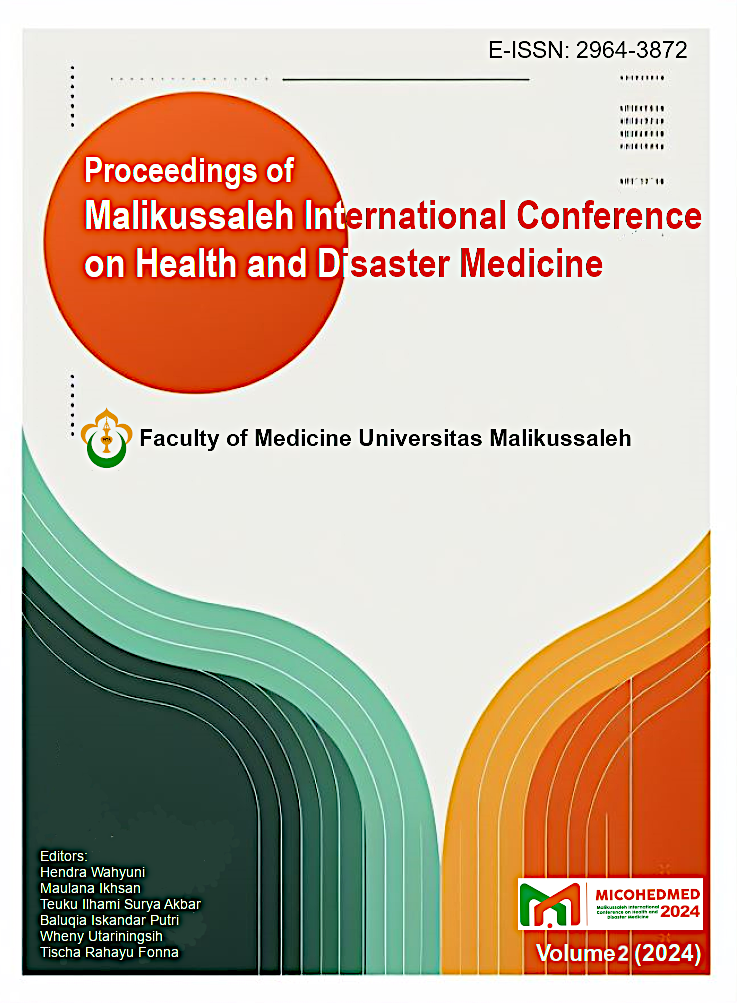Evaluation of the Sensitivity and Specificity of the Tuberculosis Sign and Symptom (TBSS) Score in Comparison with Chest Radiography and Rapid Molecular Test for Diagnosing Tuberculosis Among Brick Kiln Workers
DOI:
https://doi.org/10.29103/micohedmed.v2i.1199Keywords:
Tuberculosis, Tuberculosis Sign And Symptom Score, Chest Radiography, Rapid Molecular TestAbstract
Purpose: The aim of this study is to evaluate the sensitivity and specificity of the Tuberculosis Sign and Symptom Score in comparison to chest radiography and rapid molecular testing among brick kiln workers in Pringsewu Regency. Patients and methods: This study uses a cross-sectional design. This study used a total sampling method, with total samples are 92. The study was conducted from February to March 2024 in a brick kiln located in Saribumi Village, Gading Rejo District, Pringsewu Regency, Lampung Province. Results: The sample in this study consists of 92 subjects. The majority of the sample is female, accounting for 77.3%, while males make up 22.8%. The most common age range is 41-60 years, representing 48.9% of the total. In terms of job categories, most workers are employed in the molding section. The screening with TBSS score and chest radiography yielded a sensitivity of 0.25, specificity of 0.93, positive predictive value of 0.14, and negative predictive value of 0.96. The sensitivity and specificity between the RTM test and TB ss score cannot be assessed because the results of the RTM examination showed that all respondents were negative for TB. Conclusion: All sputum examinations using rapid molecular testing (RMT) showed negative results. Its preventing the assessment of sensitivity and specificity for this method. This discrepancy may be due to suboptimal sample quality.
References
1. Noviyani A, Nopsopon T, Id KP. Variation of tuberculosis prevalence across diagnostic approaches and geographical areas of Indonesia. 2021;9:1–12. Available from: http://dx.doi.org/10.1371/journal.pone.0258809
2. WHO. Global Tuberculosis Report. Vol. t/malaria/, January. 2023.
3. Alsayed SSR, Gunosewoyo H. Tuberculosis : Pathogenesis , Current Treatment Regimens and New Drug Targets. 2023;
4. Hidayat A, Murti B, Soedarsono S, Wahyuni CU. Simple tuberculosis screening tool using signs , symptoms , and risk factors to reduce the missed opportunity in the older population. BMC Pulm Med [Internet]. 2022;1–8. Available from: https://doi.org/10.1186/s12890-022-02001-2
5. Thomas BE, Charles N, Watson B, Chandrasekaran V, Senthil R, Dhanalakshmi A, et al. Prevalence of chest symptoms amongst brick kiln migrant workers and care seeking behaviour : a study from South India. 2014;37(4):590–6.
6. Shriraam V, Srihari R, Gayathri T, Murali L. Active case finding for Tuberculosis among migrant brick kiln workers in South India. Indian J Tuberc. 2019 Jan 1;
7. Gahlot N, Rana K, Singh K. Workplace environment assessment of brick kiln units. 2020;9(1):433–8.
8. Syam DM, Arianty R, Sulaeman DS, Subagyo I. Risk Factors for Tuberculosis in the Work Area Community Health Center Sabang, Dampelas District, Donggala Regency. 2021;9:530–4.
9. APHL. Guidelines for Submission of Sputum Specimens for Tuberculosis Testing. Assoc Public Heal Lab. 2018;(April):1–7.
Downloads
Published
How to Cite
Issue
Section
License
Copyright (c) 2024 Retno Ariza Soemarwoto, Anse Diana Valentiene Messah, Pad Dilangga, Isura Febrihartati

This work is licensed under a Creative Commons Attribution-ShareAlike 4.0 International License.
n order for Proceedings of Malikussaleh International Conference on Health and Disaster Medicine (MICOHEDMED) to publish and disseminate research articles, we need non-exclusive publishing rights (transfered from author(s) to publisher). This is determined by a publishing agreement between the Author(s) and Proceedings of Malikussaleh International Conference on Health and Disaster Medicine (MICOHEDMED). This agreement deals with the transfer or license of the copyright of publishing to Proceedings of Malikussaleh International Conference on Health and Disaster Medicine (MICOHEDMED), while Authors still retain significant rights to use and share their own published articles. Proceedings of Malikussaleh International Conference on Health and Disaster Medicine (MICOHEDMED) supports the need for authors to share, disseminate and maximize the impact of their research and these rights, in any databases.
As a proceeding Author, you have rights for a large range of uses of your article, including use by your employing institute or company. These Author rights can be exercised without the need to obtain specific permission. Authors publishing in Proceedings of Malikussaleh International Conference on Health and Disaster Medicine (MICOHEDMED) proceedings have wide rights to use their works for teaching and scholarly purposes without needing to seek permission, including:
- use for classroom teaching by Author or Author's institution and presentation at a meeting or conference and distributing copies to attendees;
- use for internal training by author's company;
- distribution to colleagues for their reseearch use;
- use in a subsequent compilation of the author's works;
- inclusion in a thesis or dissertation;
- reuse of portions or extracts from the article in other works (with full acknowledgement of final article);
- preparation of derivative works (other than commercial purposes) (with full acknowledgement of final article);
- voluntary posting on open web sites operated by author or author’s institution for scholarly purposes,
(but it should follow the open access license of Creative Common CC-by-SA License).
Authors/Readers/Third Parties can read, print and download, redistribute or republish the article (e.g. display in a repository), translate the article, download for text and data mining purposes, reuse portions or extracts from the article in other works, sell or re-use for commercial purposes, remix, transform, or build upon the material, they must distribute their contributions under the same license as the original Creative Commons Attribution-ShareAlike (CC BY-SA).




